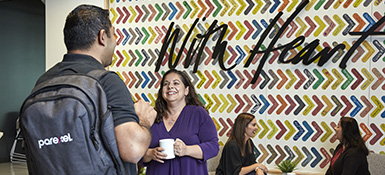Shaping the Future of Regulatory: A Day in the Life of a VP Tech at Parexel
For this exclusive interview, gain insight into how two of our VP Technical (Tech) leaders navigate their day-to-day challenges and triumphs, what sets Parexel's Regulatory team apart in the industry and more!
What has been your career to date?
Sinan: More than a decade ago, I began my regulatory career as a Senior Medical Officer at the Pharmacovigilance and Medical Devices department at the Danish Medicines Agency, but moved quickly to the Licensing Division, where I joined the Cancer Team. I was the lead clinical assessor on countless oncology products, where several are standard of care now. Shortly after joining the Cancer Team, I was nominated as a Member of the Committee for Advanced Therapies (CAT) at the European Medicines Agency (EMA) and also CHMP’s Oncology Working Party (ONCWP). I became the Chair of ONCWP later, where I was responsible for driving the EMA’s guidelines and policies in oncology. As a member of ONCWP and later a member of CHMP, I had monthly meetings with the FDA’s Oncology Center of Excellence (OCE) to discuss ongoing procedures, guidelines, designations, scientific advice, etc. This gave me an in-depth understanding of the guidelines, policies, and decisions at the OCE. I was nominated as a Member of CHMP in 2015, and shortly thereafter I was appointed chief medical officer at the Danish Medicines Agency. Based on my experience, I can provide a solid understanding of the regulatory landscape, the regulatory requirements, but also the clinical requirements.
Steve: I was recruited by CBER/FDA to be a Medical Officer in the cell and gene therapy office (called OCTGT at the time, now called OTP) from the National Heart, Lung, and Blood Institute (NHLBI) in the National Institutes of Health (NIH), where I had been doing research in the Laboratory of Molecular Cardiology as part of the NIH Clinical Associate program. At that time, FDA was looking for someone to oversee the cardiovascular cell and gene therapy INDs, and I ended up covering over 90% of those files during my 11-year tenure at FDA, first as a Primary Clinical Reviewer, then later as Team Lead, and finally as Acting Branch Chief. Although the main requirement for a Medical Officer is an M.D. degree, I feel that getting a solid background in Molecular Biology really set me up for a rewarding career in regulating cell and gene therapies at FDA.
What are the core responsibilities of a VP Tech?
Sinan: I provide strategic, regulatory, and clinical advice about the development of products, pre-IND, IND, NDA, BLA, MAA, ODD, PRIME, Fast track, Breakthrough designation, high-stake meetings, etc. Reviewing and providing gap analysis on important documents before submission to the FDA and EMA, and preparing due diligence assessment reports for different clients. I interact a lot with new and existing clients.
Steve: Our overall function is to either work directly with our clients on Regulatory issues, or together with Parexel’s other business units, such as the clinical trial operations team, to come up with integrated solutions for various issues that arise during development. I always think of the VP Tech’s as ambassadors for Parexel, since we’re front and center when it comes to helping our clients navigate the regulatory complexities of the development program and interacting with Health Authorities as the product moves from first-in-human trials toward licensure and post-marketing.
What does a typical day of a VP Tech consist of?
Sinan: It can vary a lot! At Parexel, the nature of our work in the Regulatory team is highly diverse and tailored to the specific needs of our clients. The range of projects and development programs we handle varies based on the client and the type of products involved. For instance, we might assist a prominent pharmaceutical company in exploring potential expanded uses for their existing products. On the other hand, we may provide comprehensive guidance and support for a startup biotech company in their new Investigational New Drug (IND) submission, as they may lack in-house regulatory expertise. The dynamic nature of these assignments is what makes our work at Parexel incredibly interesting and engaging.
Steve: We have internal meetings a few days a week to go over things such as key learnings that can enrich our daily work, updates on our progress in new business activities, and new initiatives for our business unit from Management; however, the bulk of each day is split between billable activities (e.g., working on either authoring or reviewing client Briefing Documents for HA meetings, serving on client Advisor Boards, answering Regulatory questions from clients) and non-billable work (e.g., working on development of training courses and what we call Thought Leadership activities that include authoring blogs/articles and presenting at conferences).
What are important considerations for the VP Tech role?
Sinan: Working as a VP Technical is like working in the emergency room (ER). You see many different things, and you need to adapt quickly from one project to another and from client to client. It is crucial to have the ability to adapt quickly and embrace new ideas that may challenge our existing beliefs.
Steve: At the heart of what we do for clients is coming up with tailored solutions that can expedite the rational development of safe and effective products, so that’s always something to keep in mind when working on any project. I’ve always found that being able to triage different projects to address urgent needs of clients can help foster a fulfilling, ongoing partnership between Parexel and its clients, since availability and dependability are important attributes that clients are looking for in consultants.
What are ‘must-have’ skills needed for the VP Tech role?
Sinan: VP Techs are expected to have the highest technical skills, but this alone doesn’t make one a great VP Tech. More importantly, you need to have that “helicopter view” that allows you to have a vision for a given product, and how to get it to the market in a timely manner, for the benefit of patients and society in general.
Steve: Some of the most important skills are critical thinking and ability to adapt prior learnings from similar regulatory situations to help clients come up with individualized solutions for their unique issues. At Parexel, VP Tech’s are key drivers of new business, so having a comfort level in what one of my mentors used to call “the soft side” of consulting, such as good communication skills, is extremely important – for example, being able to effectively convey your enthusiasm for a project by thinking through issues for which you weren’t explicitly asked by the client, really speaks to the work ethic and sense of initiative that Parexel fosters for all of its consultants, which doesn’t go unnoticed by clients.
Explore Parexel
-
 Learn More
Learn MoreMeet Mwango: SVP & Global Head of Regulatory Strategy
Mwango shares how she came to Parexel after spending 16 years at the FDA to experience the process and considerations from the drug developer’s perspective. Read about her role as a VP-Technical and what valuable advice she offers to those looking to work With Heart™.
-
 Learn More
Learn MoreOur work culture
Learn about our culture, perks, learning opportunities, and our corporate responsibility approach. Parexel's compassionate and results-driven work culture prioritizes patient care and employee growth.
Sign up for our Talent Community
Sign up and we’ll reach out with job alerts when positions that match your career interests become available. We’ll also share periodic updates about the latest company news and events.


